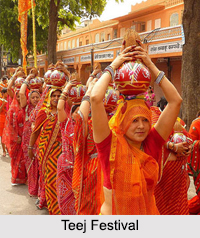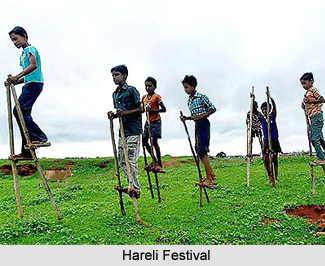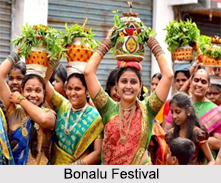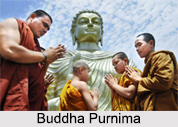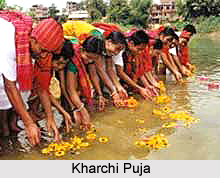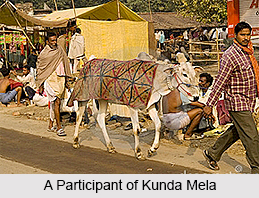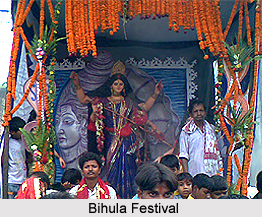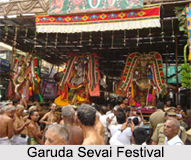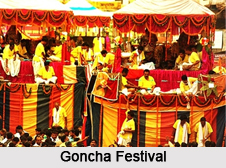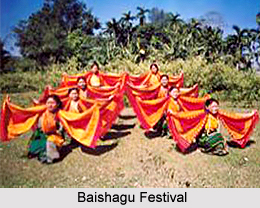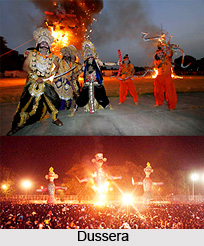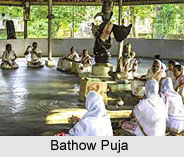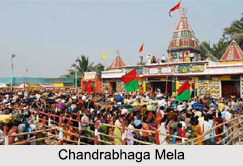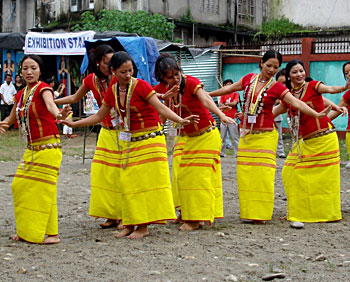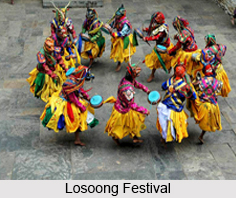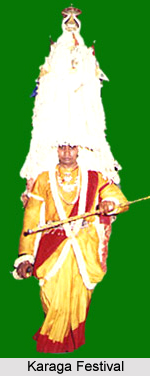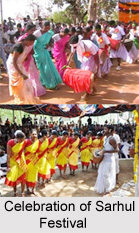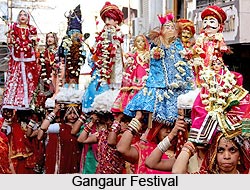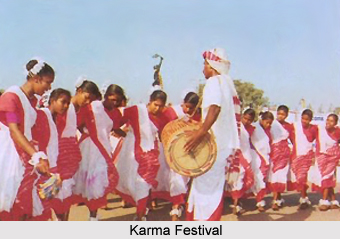Driving out evil out of a body is carried out in different means in different regions of the nation. The Shanara doctor pronounces that the devil has taken possession of the woman when he finds no explanation of the hysterical nature; he suggests that a sacrifice should be offered with a cloth and a white chicken to the doctor. To drive out the devil, moving ceremonies and powerful invocations be done. If the devil is proven to be an adamant one and refuse to leave, his withdrawal may generally be hastened by the dynamic actions of a shoe or a broom on the shoulders of the possessed person, the operator uses most slanderous language during that time. After a while, the demon eventually loses his power and the victim being tortured till now posses a sullen look, gets angry, pants about after the slippering, and cries loudly. The soul leaves the body, but before leaving it usually utters words like, "I go, I go". Then they ask the victim the name of the spirit and why he came there. He eventually narrates his death and asks them for an offering.
Or he may call himself by the name of some dead relative, who has become a demon, and was never ever imagined by the relatives. On the demon agreeing to leave, the beating is stopped and immediate arrangements are made for a sacrifice to pacify the evil spirit. The victimized person awakes from a disturbed sleep and appears to have no previous knowledge of anything that has happened.
In Kanara, the most fearsome demons are Kalkatti, Panjurli and Kallurti. Kalkatti and Kallurti were the son and daughter of a sculptor, Kalkuda. Kalkatti constructed the famous Jain statue at Karakal, and later a far better one at Yenur. The king of Karakal dissected the left hand and right leg of Kalkatti, so that he could never make a better statue, as made by him at Karakal, but still he managed to make one at Yenur. Kalkatti and his sister Kallurti resided at Yenur and in order to take revenge on the king of Karakal, set his palace ablaze and the town, thus making the people furious. These two are known to be the frightening demons. Panjurli is an awful pig faced demon, which took birth by the curse of Siva.
According to Walhous, in South Kanara, there is a well-known temple, which is said to be the address of seven most fearful demons. Devil stones that are inborn by Bhuta are sold there, which are purchased and used by the people to defend against the enemies. There are other methods of reduce the effect of the evil influences of demons living in Southern India, described by Monier Williams.
The male and female devils are known to find interest in dancing, particularly when accompanied with loud cries, violent gesticulations, ringing of bells and noisy jarring music. Hence, when deadly disease is widespread in a district, specialized training, or certain persons elected for the purpose get their faces painted, put on ugly masks, dress up in fantastic apparels. Attain strange weapons and start dancing in specific patterns. Their object is to track particular devils or force such devils to depart from the bodies of the persons of their victims. The people who are engaged in dancing, screaming and flinging themselves about and work themselves up into a frenzy of excitement amidst the beating of tom-toms, blowing of horns and ringing of bells mainly attract these souls and push them away from the victim`s sphere.
After the dancers are thoroughly worn out by their gesticulations, they sit and sink down in a kind of spell and are then believed to be actually under the possession if the spirit and are turned for a time into demon-mediums, obtaining the clairvoyance and a power of delivering farsighted utterances. The people watching the actions in gaze ask them questions about missing relatives or future events and the soul replies in oracular version.
One of the most popular festivals called Illecchi Da Nema is held at Tanjore, for neutralizing the evil power is celebrated every fifteen or twenty years. Kallyata is another festival featuring wild dance every sixtieth year in front of a particular rock or stone that is considered divine and is supposed to shiver and move occasionally. Sometimes the performance takes place in one large shelter in the center of which a common lamp burns under a canopy with images of the Bhutas all around. At the distance of about a foot in front of the lamp, a common wooden tripod stand is placed, on which is constructed a square frame of coconut leaves. Inside this created frame, a particular quantity of rice and turmeric is piled up into a heap, where a three branched iron lamp is slot in.
The offerings are arranged around this heap. The offerings comprise fruits and living victims, such as fowls and goats. The latter are ornamented with garlands and both are then executed, the warm blood is either poured out on the ground or on the altar of the heap or else drunk by the officiating priest. The idea that is still believed is that the demon is thirsty for blood and becomes aggravated if his cravings are not fulfilled. The whole purpose of sacrificing animal is to satisfy his thirst and pacify his anger.
After these preliminary ceremonies, the principal act takes place in an open air space in front of the executed victims. The priest or some other devotee, who has undergone a long preparatory ritual of fasting, comes forward to personate a fussy demon. He is dressed up in a fantastic dress, often covered with monstrous dangling ornaments and jingling bells. Often he wears a dreadful mask; sometimes his face is painted with different colors.
In one hand he holds a sword or trident and usually a bell in the other. He then starts the ritual with dancing or pacing up and down in an enthusiastic manner, amid beating of tom-toms, blowing horns and engages all kinds of noisy music. His attendant sings songs and recites rude poems describing the deeds of the demons. Meanwhile spirituous drink is distributed, the performer becomes aggressively excited and the demon takes absolute possession of him. Finally he surrenders in a hysterical mode and finally gives out oracular responses to any inquiry addressed to him. Most of the spectators consult him as to their several wants and destinies or the well-being of deceased relatives, but are not allowed to do so without giving offerings first.
On the western coast, the custom of soothing the demon (Bhuta) is quite different. There, in the villages, in every house, the ropes place a cot on the ground or put down as the abode of the Bhuta. The object is to drive out the spirit of the devil. On the last day of every lunar month, flowers are offered on the cot and incense sticks are burnt before it. Once every year, in the month of April, a ceremony called Tambila is performed in front of the devil. During this ritual, fried rice is mixed with coarse sugar and structured into a ball and is placed on plantain leaves on the cot.
A lighted torch is kept in front of the ball and it is duly turned yellow with turmeric. A fowl with its throat cut is held above the light ball and the blood is allowed to drop at slow pace on the ball. If any member of the family were suffering from some unusual attack, then the face of the fowl is moved towards him, the neck of the fowl is twisted, and the blood is made to fall on him. The priest is checked with to recommend alms to be given to him, and satisfy the hostile stars, with a promise to carry out a special ceremony to the Bhutas. The purpose of the ceremony is to offer life for life.
Kolla is held at Bhutasthan and is an annual festival held at the shrine of the Bhutas, where brass images roughly made in the form of human figures resembles pigs, tigers, fowls, etc. are placed. The festival is held at night, when all the villagers assemble. The pujari takes the Bhuta sword and a bell in his either hands and whips round and round. He imitates the gestures of the demon. A Dheda, a man of low caste approaches naked. His body is besmeared with white, yellow and red paints at the head, face and body. Against the beat of the drum, he starts a maniac dance, capering, hopping and spinning fervently. At last he stops and start to speak like a demon, in loud croaky commanding tones. Finally, the Dhera consumes food and drinks juice.
Some sorcerers mould a human image in wax, if he is asked to get rid of an enemy. The waxen figure goes before a fire and as it melts thus indicating the showering down of deadly calamities on the head of the person to be destroyed. Or, if a human bone that is derived from the cemetery is procured and certain Mantras are recited over it, very fatal results are sure to come.
Whatever the requirement may be, the fact is that no magician, wizard, sorcerer or witch, whose feats are recorded in biography, history or fable, has ever imitated to be able to realize the incantations and enchantment, half of what the Mantra ShUstris claim to have the power to effect by help of the special chanters. In some parts of India, a tiger`s claw or tooth is worn as an ornament on the neck while the ceremonies and are considered to be effective against the misfortunes, which can at any time be brought about by the spiteful spirit or by evil influences.
In some places, an image of Linga is put on, or some bright ornament like string of white cowries is worn and is supposed to catch the evil glances or divert them from the person wearing such a necklace. A small iron ring is commonly worn as an amulet. It is perfectly effective if it is inlaid with pearls. Later a lime is carried inside the turban with a great trust in its prophylactic properties.
Any ornament with a figure of Hanuman carved on it makes a commendable charm, which some demons can withstand. To ward off evil eye, a familiar custom is to position a small clay pot in front of the new house that is under construction, on which eyes, nose are drawn in black color on its face.
